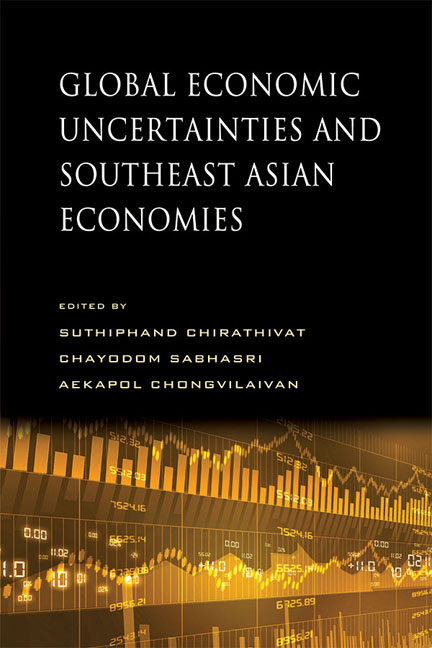Book contents
- Frontmatter
- Contents
- Preface
- Contributors
- 1 Challenges Facing a Globally Connected ASEAN
- 2 Fragile Balance of Payment in Indonesia under Global Economic Uncertainties
- 3 Malaysia in the Midst of Global Economic Uncertainties
- 4 Singapore: Reinventing Itself amid Global Economic Uncertainties
- 5 Thailand: Dependency or Diversification?
- 6 Vietnam's Economic Experience since WTO Accession
- 7 Global Economic Imbalances and Reform Policy: Evidence from Asian Economies
- 8 Foreign Exchange Rate Adjustment Policies in Asia
- 9 Monetary and Financial Architectures for ASEAN+
- 10 Global Uncertainties: Implications for the ASEAN Community
- Index
1 - Challenges Facing a Globally Connected ASEAN
Published online by Cambridge University Press: 22 July 2017
- Frontmatter
- Contents
- Preface
- Contributors
- 1 Challenges Facing a Globally Connected ASEAN
- 2 Fragile Balance of Payment in Indonesia under Global Economic Uncertainties
- 3 Malaysia in the Midst of Global Economic Uncertainties
- 4 Singapore: Reinventing Itself amid Global Economic Uncertainties
- 5 Thailand: Dependency or Diversification?
- 6 Vietnam's Economic Experience since WTO Accession
- 7 Global Economic Imbalances and Reform Policy: Evidence from Asian Economies
- 8 Foreign Exchange Rate Adjustment Policies in Asia
- 9 Monetary and Financial Architectures for ASEAN+
- 10 Global Uncertainties: Implications for the ASEAN Community
- Index
Summary
INTRODUCTION
The countries of the Association of Southeast Asian Nations (ASEAN) are more regionally integrated and globally connected today than ever before. These features continue to grow, and have delivered significant benefits, but they also carry risks. Increased vulnerability to external shocks, as well as contagion that spreads rapidly across the region, are the main concerns. Five years after the global financial crisis (GFC), the economies of the United States and the eurozone continue to struggle, with the eurozone recovery lagging behind that of the United States. Monetary authorities have responded by sharply easing monetary policy. This has brought policy interest rates down to close to zero. Having quickly reached the interest rate floor, both the US Federal Reserve and the European Central Bank (ECB) have resorted to unconventional monetary policy through episodes of quantitative easing. The Bank of Japan, under new leadership, has recently followed suit. This has further increased liquidity in the banking system.
However, these policy moves have yet to produce the desired effect in the home countries, as private lending has failed to increase as expected. Banks are facing pressure to beef up their capital, making them hesitant to lend. Consumers and businesses are also reluctant to borrow as uncertainty remains high and confidence in the recovery remains low. All of this suggests that the problems in the eurozone are unlikely to end anytime soon. It also points to the very real possibility that the situation could indeed worsen. This remains true despite official figures showing that, technically, the recession in the eurozone came to an end in the second quarter of 2013. Nevertheless, the eurozone economy is still expected to shrink in 2013.
It is against this global backdrop that this chapter pays attention to the situation in Southeast Asia. How has the global financial turmoil affected ASEAN economies? Is there a real risk that this crisis could spread to the region? Given the fragility of the financial system, what are the possible effects of a shock to the eurozone financial system on the economies of Southeast Asia? This is a real possibility, given that vulnerability in the region has increased following massive inflows of capital and the buildup of debt related to successive bouts of quantitative easing, initially in the United States and now in Japan.
- Type
- Chapter
- Information
- Publisher: ISEAS–Yusof Ishak InstitutePrint publication year: 2015



